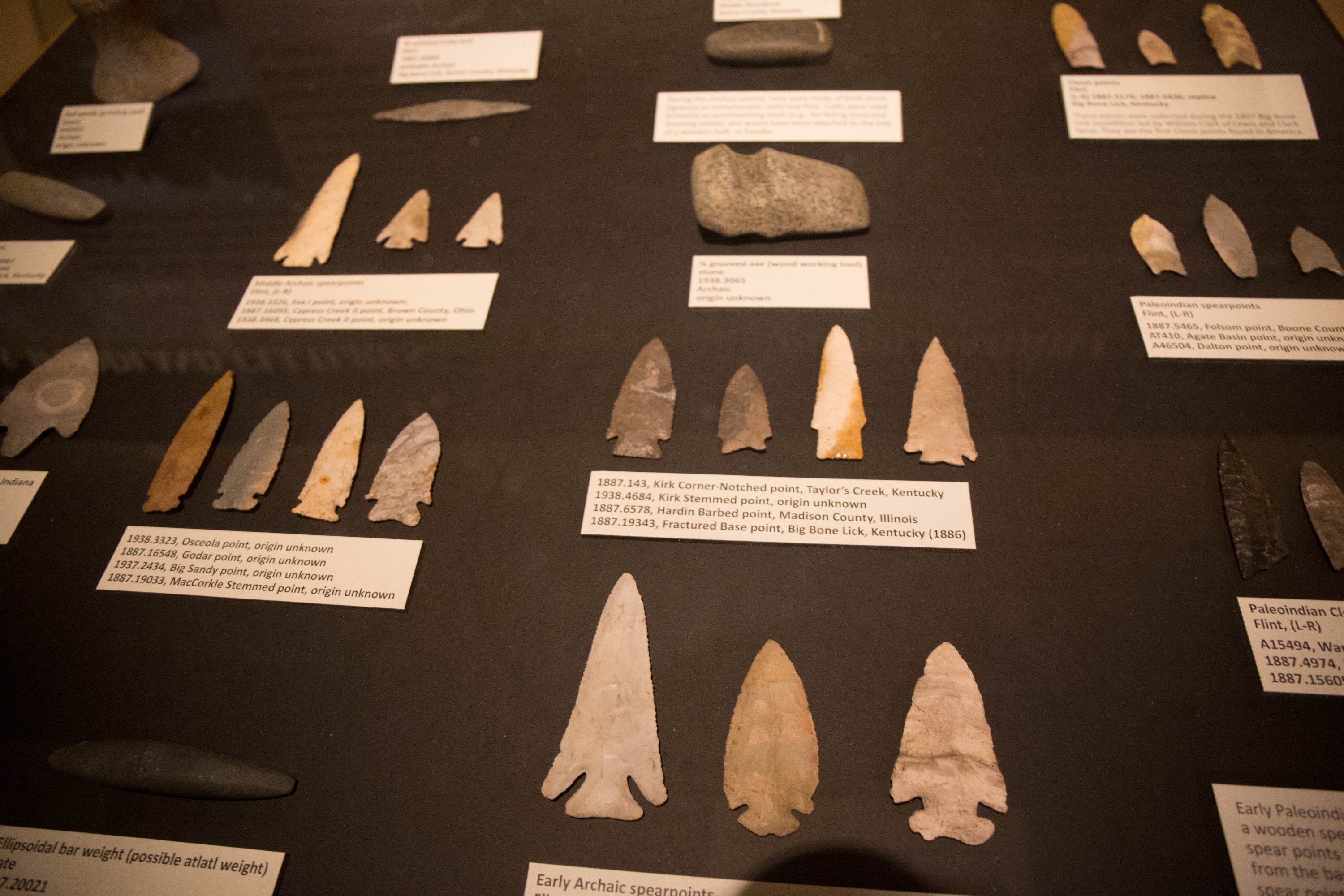
Anthropology
The Anthropology Department at Cincinnati Museum Center furthers the scientific and historical knowledge of past human societies in the Eastern Woodlands with a focus on the rich archaeological legacy of the central Ohio River valley. We acquire and preserve scientifically and historically significant collections of well-documented artifacts and preserve the archaeological record for the benefit of researchers and the public. We conduct original field and laboratory research to develop new knowledge of the archaeological record and of past human societies, and disseminate knowledge through scholarly publications, presentations and exhibits that describe and interpret the archaeological record.
Meet the Curator
Bob Genheimer
George Rieveschl Curator of Archaeology
Email: bgenheimer@cincymuseum.org
Phone: (513) 455-7161
Fax: (513) 455-7169
Biography
I am a lifelong Cincinnatian. I earned my undergraduate and graduate degrees in anthropology from the University of Cincinnati, and have been an archaeologist with Cincinnati Museum Center since 1990. I served as Archaeological Collections Manager for nearly 11 years, acting Curator of Archaeology for two years, and was named George Rieveschl Curator of Archaeology in April 2003. In these roles I have undertaken the processing and cataloguing of more than three hundred thousand artifacts in our collections. I also supervise all of the archaeology and ethnology volunteers — operating the archaeology laboratory, facilitating research on the collections, conducting field research into both prehistoric and historical archaeology and publishing the results in public and private venues. My research interests are in prehistoric and historical archaeology. My focus on prehistoric archaeology includes Late Prehistoric and Hopewell-age studies, as well as investigations into lithic technology. My interests in historical archaeology include the study of privies and urban and industrial sites, particularly nineteenth-century potteries.
Education
- B.A. Anthropology
University of Cincinnati, 1972-76 - M.A. Anthropology
University of Cincinnati, 1990-92 - Register of Professional Archaeologists, 2009-present
Excavated prehistoric site collections
The greatest strength in our archaeological collections is the extensive suite of excavated late prehistoric Fort Ancient culture (A.D. 1000-1650) artifacts and associated records. Ten excavated site collections cover the entire temporal range of the Fort Ancient culture in the Ohio River valley, from the Turpin and Guard sites, which date to approximately A.D. 1000-1250, to the well-known Madisonville site and the Clear Creek site, which date to about A.D. 1450-1650 and include early 17th century trade goods of European manufacture.
Intensive excavations of portions of the Hopewellian Fort Ancient site (in 1996-1997) and the Stubbs Earthworks site (in 1998-2001) yielded strong research collections for the Hopewellian Middle Woodland period. In particular, the Stubbs Earthworks field investigations were the most extensive archaeological excavations ever conducted at any Ohio Hopewell site. The excavations produced substantial samples of Hopewell material culture, and intensive flotation sampling (approximately 1,500 individual samples) provides a wealth of ethnobotanical remains and microartifacts associated with more than two-dozen wooden Hopewell structures. These well-documented excavations complement earlier, extensive controlled surface collections from the Stubbs Earthworks complex. Other Hopewell contexts include salvage excavations at the Landen Mound in Warren County, Ohio.
Excavated historic site collections
The 1981-1982 excavations at the Betts Longworth Historic District in downtown Cincinnati produced over 50,000 items from well-dated 19th century contexts. Assembled mostly from privy excavations, the collection features excellent faunal and floral assemblages as well as a wide range of 19th century material culture.
In 1996-1997, historic archaeological fieldwork focused on the detailed identification of privies associated with a mid-19th century neighborhood in downtown Cincinnati. Test excavations at the Findlay Market site yielded a wealth of artifacts and information pertaining to the diet, health and daily habits of the residents of nineteenth century Cincinnati, as well as invaluable evidence on the construction, use and abandonment of urban outhouses.
In 1998, preliminary test excavations were conducted at the John P. Parker House in Ripley, Ohio. Parker was a freed slave who became a successful businessman and a "conductor" on the Underground Railroad. The excavations, undertaken prior to renovation of the house, provide a sample of 19th century industrial and domestic material culture from a small town context. In 2000, more systematic excavations sponsored by the National Park Service were conducted at the John P. Parker House site, revealing extensive fill episodes designed to raise the landform above flood levels. The footprint and associated features of Parker's iron foundry were also located.
Regional survey collections
The Museum's holdings include the collections and records of extensive site surveys conducted by regionally-based and federally-funded archaeological preservation offices from the early 1970s until 1981. These collections and records represent twelve counties along the Ohio River in south-central and southwestern Ohio: Adams, Brown, Butler, Clinton, Clermont, Hamilton, Highland, Jackson, and Lawrence, Pike, Scioto and Warren counties. The collections include systematic regional surveys, documentation of private collections from archaeological sites and extensive, gridded surface collections of some major sites, such as the Hopewellian Stubbs Earthwork Complex.
Synoptic collections
A large collection of prehistoric and proto-historic artifacts, assembled by the Cincinnati Art Museum during the late 19th and early 20th centuries, was transferred to Cincinnati Museum Center in 1991. This 50,000-artifact collection, mostly from regional contexts, includes about 26,000 projectile points and thousands of ground stone artifacts. The Museum houses nearly 1,000 complete or nearly complete Late Mississippian pottery vessels from northeastern Arkansas collected in the 19th century by C. W. Riggs. A donated collection from the well-known 19th century Point Pleasant, Ohio, pipe factories includes an extensive and well-documented type collection (55+ varieties) of approximately 1,500 clay smoking pipes.
Ethnological collections
Museum Center's ethnological collections number about 8,000 artifacts and feature a broad range of 19th and early to mid-20th century material culture from several world areas. The collections focus on the material cultures of the North American Plains (especially during the late 19th century), the American Southwest (early 20th century), and of Melanesia (1931-1932). The Melanesian collections contain about 800 objects, including the country's largest and finest collection of 41 painted tapas, and are accompanied by 1,530 annotated photographs made by a National Geographic photographer who accompanied the collecting voyage and documented the acquisition of the artifacts as well as Melanesian cultures before the cultural impacts of World War II. Museum Center's collections also contain an extensive assortment of traditional Amazonian feather-work, collected in the 1980s. The Lewis Cotlow collection includes artifacts, photographs, and feature-length films of several African, South American and South Pacific cultures.
Adjunct Staff
Lory Greenland
Adjunct Curatorial Assistant in Ethnology
Phone: (513) 455-7184
OR (513) 455-7161
Tyler Swinney
NAGPRA Coordinator/Tribal Liaison
Archaeology Collections
Phone: (513) 768-6257 Ext. 7287
Email: tswinney@cincymuseum.org
Theodore S. Sunderhaus
Research Associate

